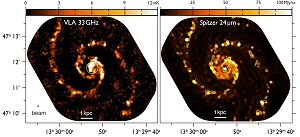- Details
- Published on 01 May 2019
Vol. 625
In section 4. Extragalactic astronomy
Dense gas is not enough: environmental variations in the star formation efficiency of dense molecular gas at 100 pc scales in M51
 Messier 51 is one of the best nearby galaxies in which to test the star formation (SF) laws in spiral galaxy disks. The authors have obtained a new 33 GHz radio-continuum map of M51 at 3 arcsec =100pc resolution and use it as an SF rate tracer, free from extinction (contrary to Halpha), and similar to mid-infrared tracer (Spitzer) but with higher spatial resolution. To derive the efficiency of SF, they compare this map to that of the molecular content (the main gas component), either from the CO(1-0) emission, or the denser gas tracer HCN(1-0), also at 100pc scale (obtained with NOEMA). They find that the gas surface density correlates well with the SF rate surface density, as was already known, but contrary to previous findings, the dense tracer HCN is no better than the CO emission. They also find a large variety from one region of the galaxy to the next, which suggests that local turbulence and the different dynamics play a large role (e.g. the presence of a spiral arm). Overall, the star formation efficiency decreases when the gas velocity dispersion increases, which confirms the role of turbulence.
Messier 51 is one of the best nearby galaxies in which to test the star formation (SF) laws in spiral galaxy disks. The authors have obtained a new 33 GHz radio-continuum map of M51 at 3 arcsec =100pc resolution and use it as an SF rate tracer, free from extinction (contrary to Halpha), and similar to mid-infrared tracer (Spitzer) but with higher spatial resolution. To derive the efficiency of SF, they compare this map to that of the molecular content (the main gas component), either from the CO(1-0) emission, or the denser gas tracer HCN(1-0), also at 100pc scale (obtained with NOEMA). They find that the gas surface density correlates well with the SF rate surface density, as was already known, but contrary to previous findings, the dense tracer HCN is no better than the CO emission. They also find a large variety from one region of the galaxy to the next, which suggests that local turbulence and the different dynamics play a large role (e.g. the presence of a spiral arm). Overall, the star formation efficiency decreases when the gas velocity dispersion increases, which confirms the role of turbulence.


